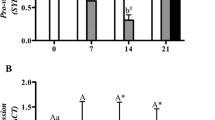Abstract
The neurohypophysial hormone arginine vasotocin (AVT) and the neuroendocrine system strongly interact with the rest of the teleostean endocrine system. The aim of this study is to investigate the effects of exposure to an endocrine disruptor on whole brain AVT concentrations for the pipefishes Syngnathus floridae and S. fuscus. Following treatment over the entire brood period, AVT concentrations were significantly higher for Aroclor 1254-exposed, post-brooding males compared to controls for both species. Considering both previously documented seventeen-fold increases in AVT for brooding males with embryos in some developmental stages and changes in parental nutrient concentrations after Aroclor 1254 exposure, these data begin to address potential physiological mechanisms that may underlie paternal activities in syngnathid males.

Similar content being viewed by others
References
Ahnesjö I (1992) Consequences of male brood care: weight and number of newborn in a sex-role reversed pipefish. Funct Ecol 6:274–281
Ashley JTF, Baker JE (1999) Hydrophobic organic contaminants in surficial sediments of Baltimore harbor: inventories and sources. Environ Toxicol Chem 18:838–849
Balment RJ, Lu W, Weybourne E, Warne JM (2006) Arginine vasotocin a key hormone in fish physiology and behavior: a review with insights from mammalian models. Gen Comp Endocrinol 147:9–16
Berglund A, Rosenqvist G, Svensson I (1989) Reproductive success of females limited by males in two pipefish species. Am Nat 133:506–516
Braford MR, Northcutt RG (1983) Organization of the diencephalon and pretectum of the ray finned fishes In: Davis RE, Northcutt RG (eds) Fish neurobiology. University of Michigan, Ann Arbor, pp 117–164
Coburn CG, Gillard ER, Currás-Collazo MC (2005) Dietary exposure to Aroclor 1254 alters central and peripheral vasopressin release in response to dehydration in the rat. Toxicol Sci 84:149–156
Foster GD, Lippa KA, Miller CV (2000) Seasonal concentrations of organic contaminants at the fall line of the Susquehanna River basin and estimated fluxes to Northern Chesapeake Bay, USA. Environ Toxicol Chem 19:992–1001
Gozdowska M, Kleszczyńska A, Sokołowska E, Kulczykowska E (2006) Arginine vasotocin (AVT) and isotocin (IT) in fish brain: diurnal and seasonal variations. Comp Biochem Physiol B 143:330–334
Hontela A, Rasmussen JB, Ko D, Lederis K, Chevalier G (1991) Arginine vasotocin, an osmoregulatory hormone, as a potential indicator of acid stress in fish. Can J Fish Aquat Sci 48:238–242
Hontela A, Rasmussen JB, Lederis K, Tra HV, Chevalier G (1993) Elevated levels of arginine vasotocin in the brain of brook trout (Salvelinus fontinalis) from acid lakes: a field test of a potential biomarker for acid stress. Can J Fish Aquat Sci 50:1717–1727
Jobling M (1995) Environmental biology of fishes. Chapman & Hall, London
Kime DE (2001) Endocrine disruption in fish. Kluwer, Boston
Kulczykowska E (1999) Diel changes in plasma arginine vasotocin, isotocin, and melatonin in rainbow trout (Oncorhynchus mykiss). Fish Physiol Biochem 21:141–146
Kulczykowska E (2001) Responses of circulating arginine vasotocin, isotocin and melatonin to osmotic and disturbance stress in rainbow trout (Oncorhynchus mykiss). Fish Physiol Biochem 24:201–206
Mancera JM, Vargas-Chacoff L, Garcia-López A, Keszcyóska A, Kalamarz H, Martinez-Rodríguez G, Kulczykowska E (2008) High density and food deprivation affect arginine vasotocin, isotocin and melatonin in gilthead sea bream (Sparus auratus). Comp Biochem Physiol A 149:92–97
Ripley JL (2009) Osmoregulatory role of the paternal brood pouch for two Syngnathus species. Comp Biochem Physiol A 154:98–104
Ripley JL, Foran CM (2006a) Differential parental nutrient allocation in two congeneric pipefish species (Syngnathidae: Syngnathus spp.). J Exp Biol 209:1112–1121
Ripley JL, Foran CM (2006b) Population structure, growth rates, and seasonal abundance of two Syngnathus pipefish species. Estuar Coasts 29:1161–1171
Ripley JL, Foran CM (2008) Interspecific differences of parental polychlorinated biphenyl exposure on nutrient availability, egg production and brooding in two Syngnathus species. J Fish Biol 72:1369–1385
Ripley JL, Foran CM (2009a) Direct evidence for embryonic uptake of paternally-derived nutrients in two pipefishes (Syngnathidae: Syngnathus spp.). J Comp Physiol B 179:325–333
Ripley JL, Foran CM (2009b) Quantification of whole brain arginine vasotocin for two Syngnathus pipefishes: elevated concentrations correlated with paternal brooding. Fish Physiol Biochem. doi:10.1007/s10695-009-9361-3
Semsar K, Perreault HAN, Godwin J (2004) Fluoxetine-treated male wrasses exhibit low AVT expression. Brain Res 1029:141–147
Stölting KN, Wilson AB (2007) Male pregnancy in seahorses and pipefish: beyond the mammalian model. BioEassays 29:884–896
Acknowledgments
We thank the Marine Science Consortium of Wallops Island, VA, USA for the use of their facility and equipment. We also thank E. Anderson, B. Blaine, J. Marshall, A. Martin, H. Pagan, W. Sites, A. Shahan, B. Shock, and T. Stueckle for assistance in field collections and laboratory maintenance and J. Flores for the use of his sonicator. Pipefish collection was approved by the Commonwealth of Virginia Marine Resources Commission (permits 04-21, 05-18, and 06-56). All laboratory animal care and methods complied with regulations enforced by the West Virginia University Animal Care and Use Committee [protocols 03-0501 (November 2003) and 06-0503 (June 2006)]. This research was supported by the Oak Ridge Associated Universities, the West Virginia University Research Corporation, and the West Virginia University Department of Biology. Current funding is provided by the National Science Foundation grant IOS-0722120.
Author information
Authors and Affiliations
Corresponding author
Rights and permissions
About this article
Cite this article
Ripley, J.L., Foran, C.M. Elevated whole brain arginine vasotocin with Aroclor 1254 exposure in two Syngnathus pipefishes. Fish Physiol Biochem 36, 917–921 (2010). https://doi.org/10.1007/s10695-009-9368-9
Received:
Accepted:
Published:
Issue Date:
DOI: https://doi.org/10.1007/s10695-009-9368-9




